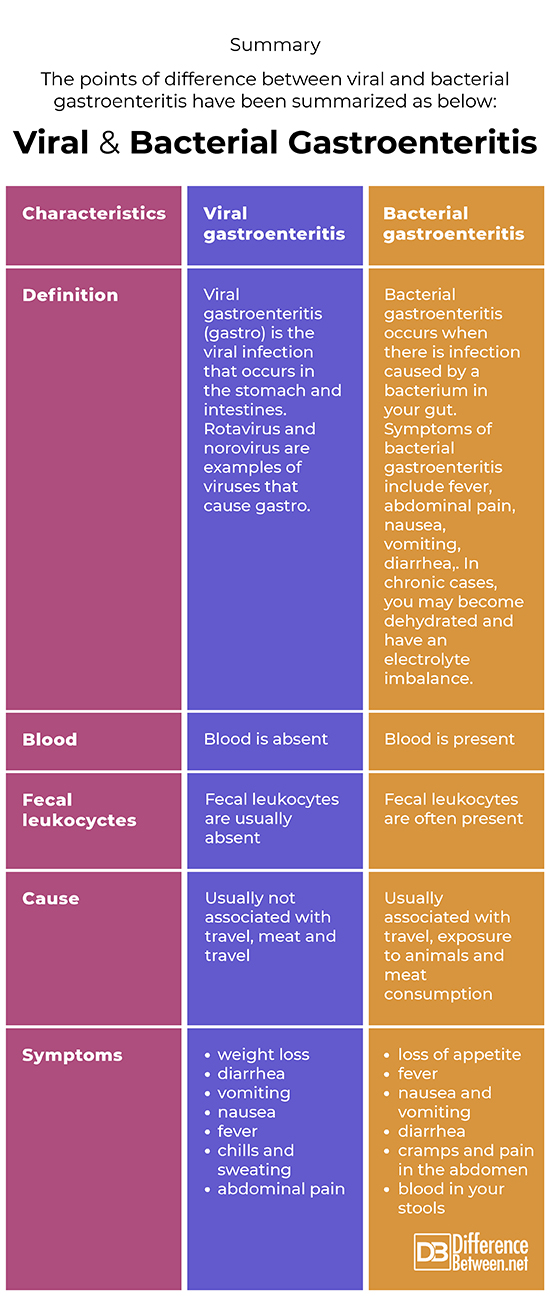Difference Between Viral and Bacterial Gastroenteritis

What is viral and bacterial gastroenteritis?
It is important to know the type of infection based on the gastrointestinal symptoms. In viral infections, diarrhea is usually watery, without blood or mucus. Conversely, in bacterial diarrhea, diarrhea with mucus and blood is more common.

Similarity
Both viruses and bacteria can cause gastroenteritis. In both viral and bacterial gastroenteritis
Viral Gastroenteritis
Symptoms of viral gastroenteritis (stomach flu or gastro) include muscle aches, vomiting and watery diarrhea, which are caused by inflammation and irritation of the inside linings of the stomach and intestines. In most cases, viral gastroenteritis infection does not last for more than a few days and so the symptoms reduce usually without any treatment. However, one big danger in this condition is that diarrhea and vomiting can cause dehydration.
Bacterial Gastroenteritis
Bacterial gastroenteritis (digestive disorder caused due to bacteria) is an inflammation of the gastrointestinal tract caused by infectious bacteria. Symptoms, such as vomiting, severe abdominal pain, and diarrhea, are common and can be mistaken for a viral infection. However, this condition can also be referred to as food poisoning due to exposure to animals or the ingestion of contaminated foods or water.
Difference between viral gastroenteritis and bacterial gastroenteritis
Definition
Viral Gastroenteritis
When a virus is responsible for infection in the gut and the intestines, the condition is termed as viral gastroenteritis (gastro). Rotaviruses and noroviruses are examples of viruses causing viral gastroenteritis.
Bacterial Gastroenteritis
The bacterial infection – bacterial gastroenteritis is caused by bacteria. In severe cases, one may suffer from chronic dehydration that could result in electrolyte imbalance (when you have too many or too little minerals in your body). It causes abdominal cramping, nausea, vomiting, fever, diarrhea with blood, stomach pain, and stomach aches. In some cases, antibiotics are needed to treat bacterial gastroenteritis.
Causes
Viral Gastroenteritis
Rotavirus and norovirus are examples of viruses that cause gastro.
Bacterial Gastroenteritis
Bacterial gastroenteritis is caused by Shigella, Campylobacter jejuni, Escherichia coli, and Salmonella
Types
Viral Gastroenteritis
– Rotavirus – which is common in small babies between the ages of three and fifteen months. The infection is most common in the fall and winter.
– Norovirus, which causes infection in adults has incubation period of 12 – 48 hours. It is the most common virus that is highly contagious and causes outbreaks on cruise ships. Symptoms can occur at any time of the year and last for one to three days. Symptoms last for 5 to 12 days for children under the age of 2.
– Adenovirus. This virus causes mild flu and occurs all year round. It usually infects kids under the age of 2.
Bacterial Gastroenteritis
- Campylobacter jejuni – found in poultry and
- E coli – present in beef and salads
- Salmonella – meat, eggs and dairy products
- Shigella – swimming pools
- Staphylococcus – present in dairy products, eggs and meat
- Yersinia – present in pork
Symptoms
Viral Gastroenteritis
Clammy skin, sunken eyes, dry lips and skin, loss of appetite, drowsiness, no thirst, minimal to no urination joint aches. Other symptoms include nausea, vomiting, watery loose diarrhea.
Bacterial Gastroenteritis
A bacterial gastroenteritis occurs when food or water has become contaminated with bacteria or their toxins. It can cause diarrhea, abdominal cramps, nausea, and vomiting.
Diagnosis
Viral Gastroenteritis
Your doctor will look for signs of dehydration, including:
- Low blood pressure
- No tears
- Eyes that look sunken
- Coma or lethargy
- Sticky or dry mouth
- Low or no urine output
The doctor will take a stool sample to look for viruses that is causing the sickness. In some cases, stool culture is done to check if the infection is caused by bacteria.
Bacterial Gastroenteritis
The healthcare provider may asl for a stool sample to test and determine whether the infection is bacterial or viral.
Summary
The points of difference between viral and bacterial gastroenteritis have been summarized as below:

FAQ:
How do you know if gastroenteritis is viral?
Viral gastroenteritis is characterized by watery diarrhea without mucus or blood, vomiting, headache, fever, and abdominal cramps (“stomach ache”).
How do you rule out bacterial gastroenteritis?
Symptoms, a physical exam, and sometimes the presence of similar cases in your community will be used by your doctor to diagnose bacterial gastroenteritis (stomach flu).
Will bacterial gastroenteritis go away on its own?
Bacterial gastroenteritis does not usually need treatment and very often leaves the body without any treatment. However, the affected person should keep his or her body hydrated and drink plenty of water to replace the fluids lost through vomiting or diarrhea.
What is the fastest way to cure viral gastroenteritis?
You don’t need a specific treatment to cure viral gastroenteritis. Rehydration is the mantra. Just keep sipping fluids and water and take adequate rest until the virus leaves your system. In rare cases, you may need IV (intravenous) fluids to treat severe dehydration.
Should I go to the ER for viral gastroenteritis?
Most viral infections can be treated at home. However, if you have severe symptoms which you feel cannot be treated at home such as a high fever, severe abdominal pain, vomiting or loose stool or diarrhea lasting more than two days, you should see your health care provider.
- Difference Between Global Warming and Greenhouse Effect - May 18, 2024
- Difference Between Vaccination and Immunization - March 3, 2024
- Difference Between Selective Mutism and Autism - February 25, 2024
Search DifferenceBetween.net :
Leave a Response
References :
[0]Barrett, J., & Fhogartaigh, C. N. (2017). Bacterial gastroenteritis. Medicine, 45(11), 683-689.
[1]Bányai, K., Estes, M. K., Martella, V., & Parashar, U. D. (2018). Viral gastroenteritis. The Lancet, 392(10142), 175-186.
[2]Clark, B., & McKendrick, M. (2004). A review of viral gastroenteritis. Current opinion in infectious diseases, 17(5), 461-469.
[3]Fhogartaigh, C. N., & Edgeworth, J. D. (2009). Bacterial gastroenteritis. Medicine, 37(11), 586-593.
